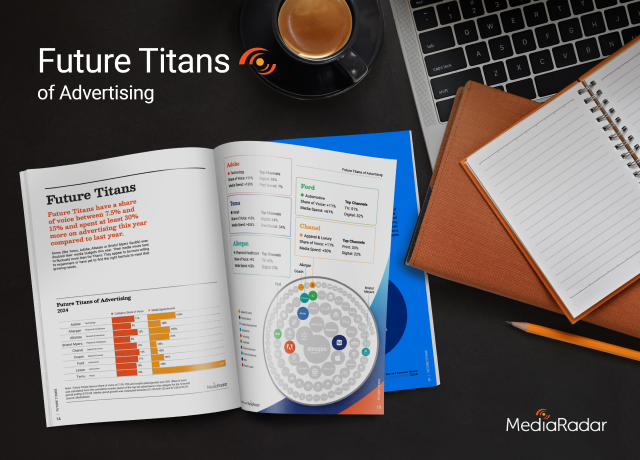Almost six months out from Super Bowl LVII, Fox had sold nearly all of its available inventory, with some brands spending upward of $7mm to get into the living rooms of millions.
The NFL’s biggest stage has long been the gold standard for advertisers with deep pockets. For example, Anheuser-Busch spent more than $52mm during the Super Bowl in 2021 as part of its overall TV-heavy strategy (90% devoted to TV in 2022).
Still, Super Bowl ads don’t come without risk, as measurement and targeting capabilities often set them back from their digital counterparts.
The lofty price tag doesn’t guarantee a return either, especially as fewer Americans tune into the Big Game.
While these pitfalls are often enough to keep more cash-strapped advertisers away, those with seemingly blank checks don’t seem overly concerned.
We looked at our data to understand how they spent in years past and what may be on the table during Super Bowl LVII.

Super Bowl LV vs. Super Bowl LVI: How Are Advertisers Spending?
Despite falling viewership over the past decade, advertisers for some popular brands refuse to sit on the sidelines.
According to our data, advertisers spent 35% more YoY on Super Bowl LVI than they did for Super Bowl LV. At the same time, the number of brands investing in this advertising gold jumped by 10% YoY.
While most people steer clear of goods and services that increase by an exuberant amount in perpetuity, a select group of advertisers refuses to admit that “sticker shock” is a thing.
In 2021, 119 brands spent $525mm on 30-second ads that cost around $5.6mm. Meanwhile, in 2022, when a 30-second spot cost $6.5mm, 131 brands spent nearly $710mm.
Could that be a result of the (potentially) pandemic-driven jump in viewership last year? Absolutely, but it also points to the fact that money is no object for some advertisers.
Prices are high, sure, but these ads give multi-billion-dollar brands a surefire way to get their names into the living rooms of millions and drive awareness like no other time of the year.
Here’s how the biggest Super Bowl advertisers spent the past two years for LV and LVI, and our predictions on what LVII advertising will look like:
Media & Entertainment
In 2022, media & entertainment advertisers accounted for 26% of overall Super Bowl spending, with the top three drivers coming from drama TV shows, subscription streaming services, and sci-fi/fantasy films (Jurassic World Dominion).
In contrast, 2021’s Big Game saw most of its media & entertainment ad dollars come from those promoting subscription streaming services, corporate campaigns, and job websites, the latter of which undoubtedly stemmed from the recession and the Great Resignation.
Last year, advertisers from major streaming services, including Amazon, Disney+, HBO, and Peacock, spent big to stay ahead in the increasingly competitive market. Advertisers for Paramount+, who invested in 2021, saw their services grow but nevertheless sat that one out.
Netflix, Peacock, and YouTube also strengthened the presence of streaming services with a series of ads during the Super Bowl.
Automotive
Outside of the media & entertainment industry, automotive (General Motors and Toyota) opened their wallets both in 2021 and 2022.
For the long-standing automotive advertisers, including those for GM and Toyota who promoted pickup trucks in 2021, strategies will likely look different in 2023 as electric vehicles (EVs) take center stage.
Although legacy automotive advertisers like GM and Toyota will likely showcase their take on the electric revolution, those for other EVs, including Hyundai, Lucid Motors, Volkswagen, Kia, and Nissan, may also plug the Super Bowl into their strategies. Kia and Nissan, in particular, could be set to spend big given their run during Super Bowl LVI.
Tech
Advertisers in technology included Google, Samsung, Verizon and T-Mobile advertising mobile phones, and Salesforce advertising their CRM platform.
Google and Samsung did not advertise in 2021. Verizon and T-Mobile had LVI ad spots, and returned again in 2022. Salesforce joined the big stage for the first time with a commercial starring Matthew McConaughey.
Alcohol Advertising: Anheuser Busch Has Some Competition
After more than 30 years of having exclusive rights to running ads on the NFL’s brightest lights, Anheuser-Busch’s reign is over—and other advertisers are diving in head first.
It’s worth noting that Anheuser-Busch won’t be absent from this year’s Super Bowl, with the company announcing a series of ads to promote Bud Light, Busch Light, and Michelob Ultra.
According to the company’s Chief Marketing Officer (CMO), Benoit Garbe, “Anheuser-Busch has a long history of delivering big for fans during Super Bowl, and this year is no exception.” He went on to say, “As we’ve been doing for decades, A-B will once again lead the alcohol category with total minutes of in-game creative delivered by our iconic and high-growth brands.”
Crown Royal (Diageo) and Remy Martin (Remy Cointreau) are two brands looking to take advantage of the unprecedented opening, with the former planning a 30-second ad that’ll celebrate the whisky’s heritage and gratitude.
The big investment in TV is far from surprising given that Crown Royal’s ad strategy in 2022 revolved almost exclusively around the traditional format (89%). The remainder of the company’s budget went to magazines (1.6%) and a mix of digital media, including OTT (3%).
For Remy Martin, 2023 will mark the company’s first adventure away from a regional-only strategy. According to Remy Martin’s CEO, “This national campaign reinforces our continued investment in having our brands show up during one of the biggest sports moments of the year and is a major milestone in the growth of Rémy Martin.”
The ad for one of the world’s most popular cognac brands is expected to depict “how teamwork and the pursuit of excellence drive us forward,” according to a brand statement.”
While Crown Royal’s investment in the Super Bowl makes sense given its penchant for TV ads, Remy Cointreau’s goes against the grain. In 2022, advertisers for Remy Cointreau spent just 27% of their budget on TV. What’s more, broadcast and cable ads were both down by 57% and 75% YoY, respectively.
Meanwhile, advertisers Heineken may use the Super Bowl as a way to give the company an edge in the booming world of non-alcoholic drinks.
Of course, this isn’t the only time alcohol advertisers shine. The alcoholic drinks market, which is expected to grow at a compound annual growth rate (CAGR) of 5.55% between 2023 and 2027, warrants spending year-round.
In 2022, advertisers for alcoholic drinks spent more than $1.6b, with the most dollars coming in Q4 when they spent $505mm, representing a 35% QoQ increase from Q3.
In Q1, Q2, and Q3, advertisers spent around $367mm, $405mm, and $375mm, respectively.
What Else to Expect from Advertisers During Super Bowl LVI
It can sometimes seem like certain advertisers have season tickets to the Super Bowl yearly—and rightfully so. Consumers have come to expect engaging ads from companies like Anheuser-Busch and GM. Budweiser’s Clydesdales are the perfect example of an anticipated appearance.
Next up in our Super Bowl Advertising Dive—crypto advertisers. Stay tuned.
For more insights, sign up for MediaRadar’s blog here.



